Internal Heat Gains in a Lunar Base—A Contemporary Case Study
Abstract
1. Introduction
1.1. Analogue Planetary Bases
1.2. LUNARES
1.3. Internal Heat Gains
1.4. Internal Heat Gains in Extraterrestrial Buildings
2. Materials and Methods
2.1. Assumptions
2.2. Method
- thorough inspection of all electric devices inside the station, i.e., learning their input power and daily use;
- surveying the crew members on their biometrics, physical activities, electric devices they used during the mission, and information about a lack of equipment for their personal or scientific needs.
- their mission assignments, sex, body weight and height;
- daily profile of their physical activities;
- electric devices brought for their personal use or research purposes;
- personal use electric devices, laboratory equipment, subsystems, or installations that LUNARES lacks for long-term lunar mission.
- electric devices (existing base equipment, crew’s personal devices and supplementary equipment, including life support);
- occupational heat sources (sensible body heat and occupational latent heat);
- energy storage system.
2.3. Heat Loads from Electric Devices
2.4. Occupational Heat Loads
2.4.1. Sensible Body Heat
2.4.2. Occupational Latent Heat
2.5. Heat Load from Energy Storage System
3. Results and Discussion
3.1. Electric Devices
3.1.1. Existing Base Equipment
3.1.2. Crew’s Personal Devices
3.1.3. Supplementary Devices
3.2. Occupational Heat Loads
3.3. Energy Storage System
3.4. Total Internal Heat Gains
3.5. Parametric Study
3.5.1. Overall Assumptions
- -
- number of occupants (the base crew);
- -
- mean body surface area of the crew;
- -
- intravehicular physical activity profile;
- -
- power demand of electrical devices, representing potentially variable base inventory and its use;
- -
- type of applied ESS.
3.5.2. Detailed Assumptions and Parameter Range
- -
- habitation dependent (HD) power demand: devices belonging to this category are either fully operational and constantly use nominal power when the base is inhabited, or are completely deactivated when the base remains temporarily uninhabited;
- -
- occupancy independent or partially dependent: these devices operate continuously, but their instantaneous power demand may, to some extent, depend on the actual number of base occupants;
- -
- fully dependent (FD) on occupancy: the daily mean power demand of these devices is directly proportional to the actual number of base occupants.
3.5.3. Studied Combinations
3.5.4. Results and Discussion
4. Conclusions
Author Contributions
Funding
Acknowledgments
Conflicts of Interest
Nomenclature
| ISS | International Space Station |
| TCS | thermal control system |
| ESS | energy storage system |
| EVA | extra vehicular activity |
| PV | photovoltaic |
| RFC | regenerative fuel cell |
| Li-ion | lithium-ion |
| BSA | body surface area (m2) |
| MET | metabolic equivalent of task |
| PA | physical activities |
| TPR | total performance ratio |
| IHG | internal heat gain |
| LD | lunar day |
| LN | lunar night |
| η | energy efficiency (%) |
| Q | daily mean heat gain/heat load (W) |
| q | daily mean heat gain/heat load per unit floor surface (W/m2) |
| P | power (W) |
| t | time (h) |
| e | specific energy (Wh/kg) |
| CN | number of the base inhabitants |
| ODF | occupancy dependence factor |
| CPD | Power demand coefficient |
| NASA | National Aeronautics and Space Administration |
| LED | Light-Emitting Diode |
| SocSenSys | Social Sensing System |
| g | Earth’s gravity |
| Subscripts | |
| ED | electric device |
| Ch | charging |
| RT | round trip |
| reg | regenerative cycle |
| dis | discharge cycle |
| AED | active electric devices |
| BE | base equipment |
| SBH | sensible body heat |
| d | Earth daytime |
| n | Earth night-time |
| LD | lunar day |
| LN | lunar night |
| OLH | occupational latent heat |
| Occ | occupational heat load |
| PD | personal devices |
| SD | supplementary devices or supplementary equipment |
| ESS | energy storage system |
| 0 | initial value |
| int | internal |
| ext | external |
| CL | cooling load |
| TCS | temperature control system |
References
- Publications HI-SEAS. Available online: http://hi-seas.org/wp-content/uploads/2016/05/HISEASMediaKit_01APR2016.pdf (accessed on 4 June 2020).
- FMARS—Flashline Mars Arctic Research Station. Available online: http://fmars.marssociety.org/ (accessed on 4 June 2020).
- Mars Desert Research Station. Available online: https://mdrs.marssociety.org/ (accessed on 4 June 2020).
- Heinicke, C.; Orzechowski, L.; Abdullah, R.; von Einem, M.; Arnhof, M. Updated design concepts of the Moon and Mars Base Analog (MaMBA). In Proceedings of the European Planetary Science Congress 2018, Berlin, Germany, 16–21 September 2018. id. EPSC2018-599. [Google Scholar]
- Elsarrag, E.; Alhorr, Y. Modelling the thermal energy demand of a Passive-House in the Gulf Region: The impact of thermal insulation. Int. J. Sustain. Built Environ. 2012, 1, 1–15. [Google Scholar] [CrossRef]
- Coşkun, T.; Turhan, C.; Arsan, Z.D.; Akkurt, G.G. The importance of internal heat gains for building cooling design. J. Therm. Eng. 2017, 3, 1060–1064. [Google Scholar] [CrossRef]
- Internal Heat Gain—An Overview ScienceDirect Topics. Available online: https://www.sciencedirect.com/topics/engineering/internal-heat-gain (accessed on 19 January 2020).
- Monstvilas, E.; Banionis, K.; Stankevičius, V.; Karbauskaite, J.; Bliūdžius, R. Heat gains in buildings—Limit conditions for calculating energy consumption. J. Civ. Eng. Manag. 2010, 16, 439–450. [Google Scholar] [CrossRef]
- Baglivo, C.; Congedo, P.M.; Di Cataldo, M.; Coluccia, L.D.; D’Agostino, D. Envelope design optimization by thermal modelling of a building in a warm climate. Energies 2017, 10, 1808. [Google Scholar] [CrossRef]
- Albatici, R.; Passerini, F.; Pfafferott, J. Energy performance of verandas in the building retrofit process. Energies 2016, 9, 365. [Google Scholar] [CrossRef]
- Ahn, B.; Park, J.; Yoo, S.; Kim, J.; Leigh, S.; Jang, C. Savings in cooling energy with a thermal management system for led lighting in office buildings. Energies 2015, 8, 6658–6671. [Google Scholar] [CrossRef]
- Park, S.; Kim, D.; Joe, G.; Ryu, S.; Yeo, M.; Kim, K. Establishing boundary conditions considering influence factors of the room equipped with a ceiling radiant cooling panel. Energies 2020, 13, 1684. [Google Scholar] [CrossRef]
- Hanford, A.J. (Ed.) Advanced Life Support Baseline Values and Assumptions Document; NASA/CR-2004-208941; Lockheed Martin Space Operations: Houston, TX, USA, 2004. [Google Scholar]
- Simonsen, L.C.; DeBarro, M.J.; Farmer, J.T.; Thomas, C.C. Conceptual design of a lunar base thermal control system. In Proceedings of the NASA Symposium on Lunar Bases and Space Activities in the 21st Century, Houston, TX, USA, 5–7 April 1988. LBS-88-225. [Google Scholar]
- Swanson, T.D.; Radermacher, R.; Costello, F.A.; Moore, J.S.; Mengers, D.R. low-temperature thermal control for a lunar base. SAE Tech. Pap. 1990, 901242. [Google Scholar] [CrossRef]
- Simonsen, L.J.; DeBarro, M.J.; Farmer, J.T. Conceptual Design of a Lunar Base Thermal Control System. Available online: https://ntrs.nasa.gov/archive/nasa/casi.ntrs.nasa.gov/19930004815.pdf (accessed on 10 December 2019).
- Sridhar, K.R.; Gottmann, M. Lunar base thermal control systems using heat pumps. Acta Astronaut. 1996, 39, 381–394. [Google Scholar] [CrossRef]
- Kaczmarzyk, M.; Gawroński, M.; Piątkowski, G. Global database of direct solar radiation at the Moon’s surface for lunar engineering purposes. E3S Web Conf. 2018, 49, 00053. [Google Scholar] [CrossRef]
- Kaczmarzyk, M.; Gawroński, M.; Piątkowski, G. Application of Finite Difference Method for determining lunar regolith diurnal temperature distribution. E3S Web Conf. 2018, 49, 00052. [Google Scholar] [CrossRef]
- Evangelisti, L.; Guattari, C.; Gori, P.; Bianchi, F. Heat transfer study of external convective and radiative coefficients for building applications. Energy Build. 2017, 151, 429–438. [Google Scholar] [CrossRef]
- Cole, R.J.; Sturrock, N.S. The convective heat exchange at the external surface of buildings. Build. Environ. 1977, 12, 207–214. [Google Scholar] [CrossRef]
- Jayamaha, S.; Wijeysundera, N.; Chou, S. Measurement of the heat transfer coefficient for walls. Build. Environ. 1996, 31, 399–407. [Google Scholar] [CrossRef]
- Bienhoff, B. The Future of Commercial Space Transportation. Available online: https://www.thespacereview.com/article/3776/1 (accessed on 4 June 2020).
- Benaroya, H. Lunar habitats: A brief overview of issues and concepts. Reach 2017, 7–8, 14–33. [Google Scholar] [CrossRef]
- Degtyarev, A.V.; Lobanov, L.M.; Kushnar’ov, A.P.; Baranov, I.Y.; Volkov, V.S.; Perepichay, A.O.; Korotenko, V.V.; Volkova, O.A.; Osinovyy, G.G.; Lysenko, Y.A.; et al. On possibilities for development of the common-sense concept of habitats beyond the Earth. Acta Astronaut. 2020, 170, 487–498. [Google Scholar] [CrossRef]
- Landis, G.A.; Bailey, S.G. Photovoltaic power for a lunar base. Acta Astronaut. 1990, 22, 197–203. [Google Scholar] [CrossRef]
- Fraser, S.D. Theory and applications of cooling systems in lunar surface exploration. In Moon Prospective Energy and Material Resources; Badescu, V., Ed.; Springer: New York, NY, USA, 2012; p. 405. [Google Scholar]
- Kaczmarzyk, M.; Waśniowski, A. Internal heat loads in the LUNARES analogue planetary base—A case study. J. Civ. Eng. Environ. Archit. 2019, 3, 25–36. [Google Scholar] [CrossRef]
- Grabowski, M.; Marschall, M.; Sirko, W.; Debski, M.; Ziombski, M.; Horban, P.; Acedanski, S.; Peczarski, M.; Batorski, D.; Iwanicki, K. An experimental platform for quantified crowd. In Proceedings of the 24th International Conference on Computer Communication and Networks, Las Vegas, NV, USA, 3–6 August 2015. [Google Scholar]
- Rüb, I.; Matraszek, M.; Konorski, P.; Perycz, M. 30 Sensors to Mars: Toward distributed support systems for astronauts in space habitats. In Proceedings of the 39th IEEE International Conference on Distributed Computing Systems (ICDCS 2019), Dallas, TX, USA, 7–10 July 2019. [Google Scholar]
- Life Support Systems—Sustaining Humans Beyond Earth. Available online: https://www.nasa.gov/content/life-support-systems (accessed on 23 January 2020).
- Hemmati, H.; Biswas, A.; Djordjevic, I. Deep space optical communications: Future perspectives and applications. Proc. IEEE 2011, 99, 2020–2039. [Google Scholar] [CrossRef]
- Ainsworth, B.; Haskell, W.; Herrmann, S.; Meckes, N.; Bassett, D.; Tudor-Locke, C.; Greer, J.; Vezina, J.; Whitt-Glover, M.; Leon, A. 2011 Compendium of physical activities: A Second update of codes and MET values. Med. Sci. Sports Exerc. 2011, 43, 1575–1581. [Google Scholar] [CrossRef]
- Dubois, D.; Dubois, E.F. A formula to estimate the approximate surface area if height and weight be known. Arch. Intern. Med. 1916, 17, 863–871. [Google Scholar] [CrossRef]
- Sanborn, W.G.; Wortz, E.C. Metabolic rates during lunar gravity simulation. Aerosp. Med. 1967, 38, 380–382. [Google Scholar] [PubMed]
- Newman, D.J.; Alexander, H.L. Human locomotion and workload for simulated lunar and Martian environments. Acta Astronaut. 1993, 29, 613–620. [Google Scholar] [CrossRef]
- Goldberg, J.H.; Alred, J.W. Prediction of physical workload in reduced gravity. Aviat. Space Environ. Med. 1988, 12, 1150–1157. [Google Scholar]
- Wortz, E.C. Work in reduced-gravity environments. Hum. Factors 1969, 11, 433–439. [Google Scholar] [CrossRef] [PubMed]
- Robertson, W.; Wortz, E. The effects of lunar gravity on metabolic rates. In NASA Contractor Report; NASA CR-1102; NASA: Washington, DC, USA, 1968. [Google Scholar]
- Norcross, J.; Lee, L.; Clowers, K.; Morency, R.; Desantis, L.; De Witt, J.; Jones, J.; Vos, J.; Gernhardt, M. Feasibility of performing a suited 10-km ambulation on the Moon—Final report of the EVA Walkback Test (EWT). In NASA Technical Publication 2009; NASA: Washington, DC, USA, 2009; TP-2009-214796. [Google Scholar]
- Richter, C.; Braunstein, B.; Winnard, A.; Nasser, M.; Weber, T. Human biomechanical and cardiopulmonary responses to partial gravity—A systematic review. Front Physiol. 2017, 8, 583. [Google Scholar] [CrossRef] [PubMed]
- Garcia, C.P.; Chang, B.-J.; Johnson, D.W.; Bents, D.J.; Scullin, V.J.; Jakupca, I.J. Round trip energy efficiency of NASA Glenn regenerative fuel cell system. In NASA Technical Memorandum 2006; NASA: Washington, DC, USA, 2006; TM-2006-214054. [Google Scholar]
- Valøena, L.O.; Shoesmithb, M.I. The Effect of Phev and Hev Duty Cycles on Battery and Battery Pack Performance. Available online: http://umanitoba.ca/outreach/conferences/phev2007/PHEV2007/proceedings/PluginHwy_PHEV2007_PaperReviewed_Valoen.pdf (accessed on 20 January 2020).
- Lithium-Ion Batteries—An Overview. ScienceDirect. Available online: https://www.sciencedirect.com/topics/engineering/lithium-ion-battery (accessed on 22 January 2020).
- Patsios, C.; Wu, B.; Chatzinikolaou, E.; Rogers, D.; Wade, N.; Brandon, N.; Taylor, P. An integrated approach for the analysis and control of grid connected energy storage systems. J. Energy Storage 2016, 5, 48–61. [Google Scholar] [CrossRef]
- Active Thermal Control System (ATCS) Overview—NASA. Available online: https://www.nasa.gov/pdf/473486main_iss_atcs_overview.pdf (accessed on 12 January 2020).
- Neto, A.; Fiorelli, F. Comparison between detailed model simulation and artificial neural network for forecasting building energy consumption. Energy Build. 2008, 40, 2169–2176. [Google Scholar] [CrossRef]
- Kim, H.; Park, K.; Kim, H.Y.; Song, Y. Study on variation of internal heat gain in office buildings by chronology. Energies 2018, 11, 1013. [Google Scholar] [CrossRef]
- Goodfellow, H.D.; Tahti, E. Industrial Ventilation Design Guidebook; Elsevier: Amsterdam, The Netherlands, 2001; p. 1076. Available online: https://books.google.com/books/about/Industrial_Ventilation_Design_Guidebook.html?id=t9O8xvY_XoUC (accessed on 14 January 2020).
- Grigore, R.; Dima, C. Research on the influence of internal heat gains on energy performance evaluation of industrial buildings. In Proceedings of Plumee 2015; Alma Mater Publishing House: Bacau, Romania, 2015; Available online: http://pubs.ub.ro/dwnl.php?id=PLUMEE201501V05S01A0009 (accessed on 24 January 2020).
- Shiel, W.C., Jr. Medical Definition of Body Surface Area—MedicineNet. Available online: https://www.medicinenet.com/script/main/art.asp?articlekey=39851 (accessed on 1 June 2020).
- Statista—Chart: Number of Female NASA Astronauts Rises. Available online: https://www.statista.com/chart/17487/number-of-female-nasa-astronauts/ (accessed on 2 June 2020).
- Mark, S.; Iscott, G.B.; Donoviel, D.B.; Leveton, L.B.; Mahoney, E.; Charles, J.B.; Siegel, B. The Impact of Sex and Gender on Adaptation to Space: Executive Summary. Available online: https://www.ncbi.nlm.nih.gov/pmc/articles/PMC4236030/ (accessed on 2 June 2020).
- Physical Activity in Space—Canadian Space Agency. Available online: https://www.asc-csa.gc.ca/eng/astronauts/living-in-space/physical-activity-in-space.asp (accessed on 2 June 2020).
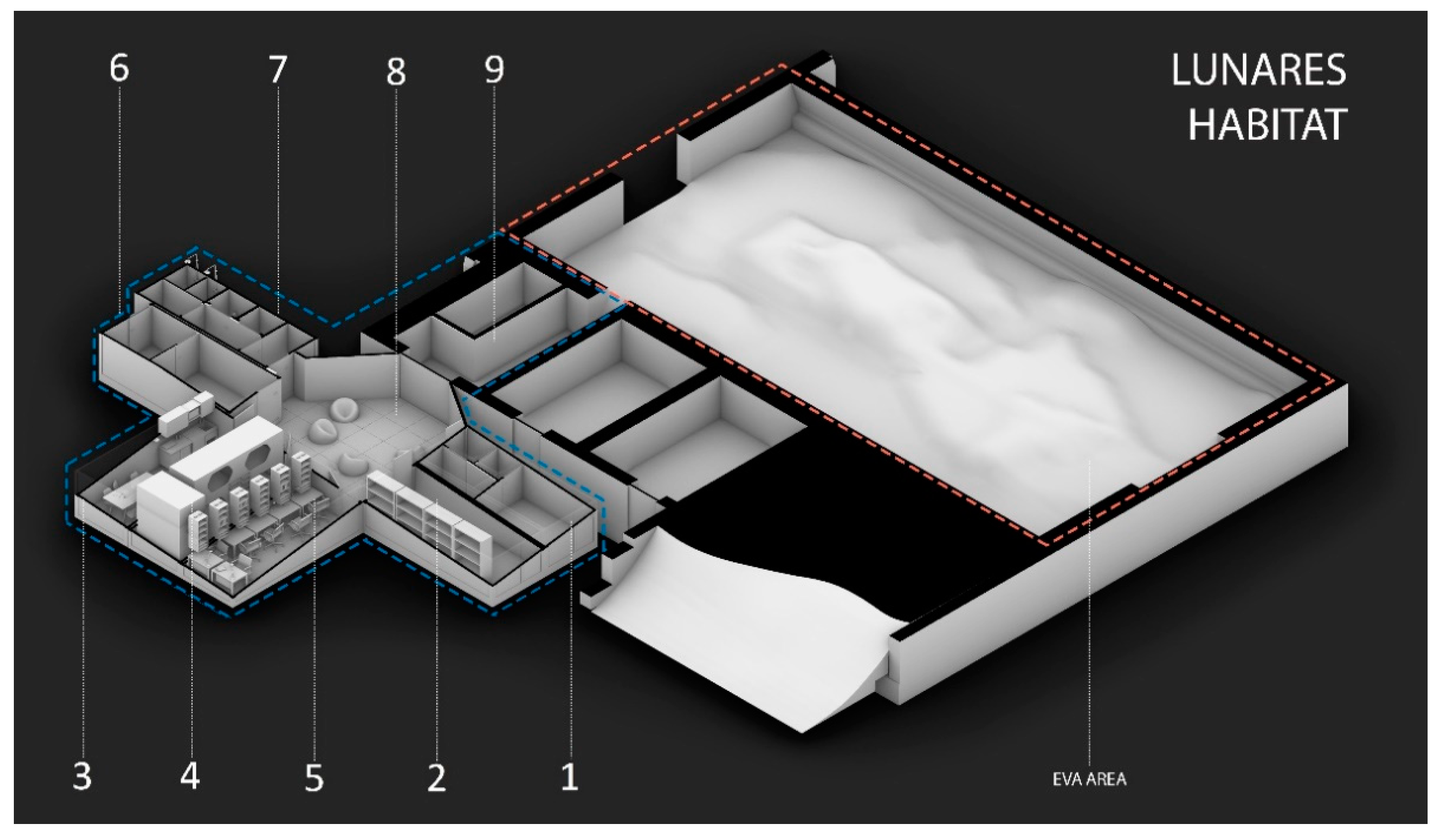
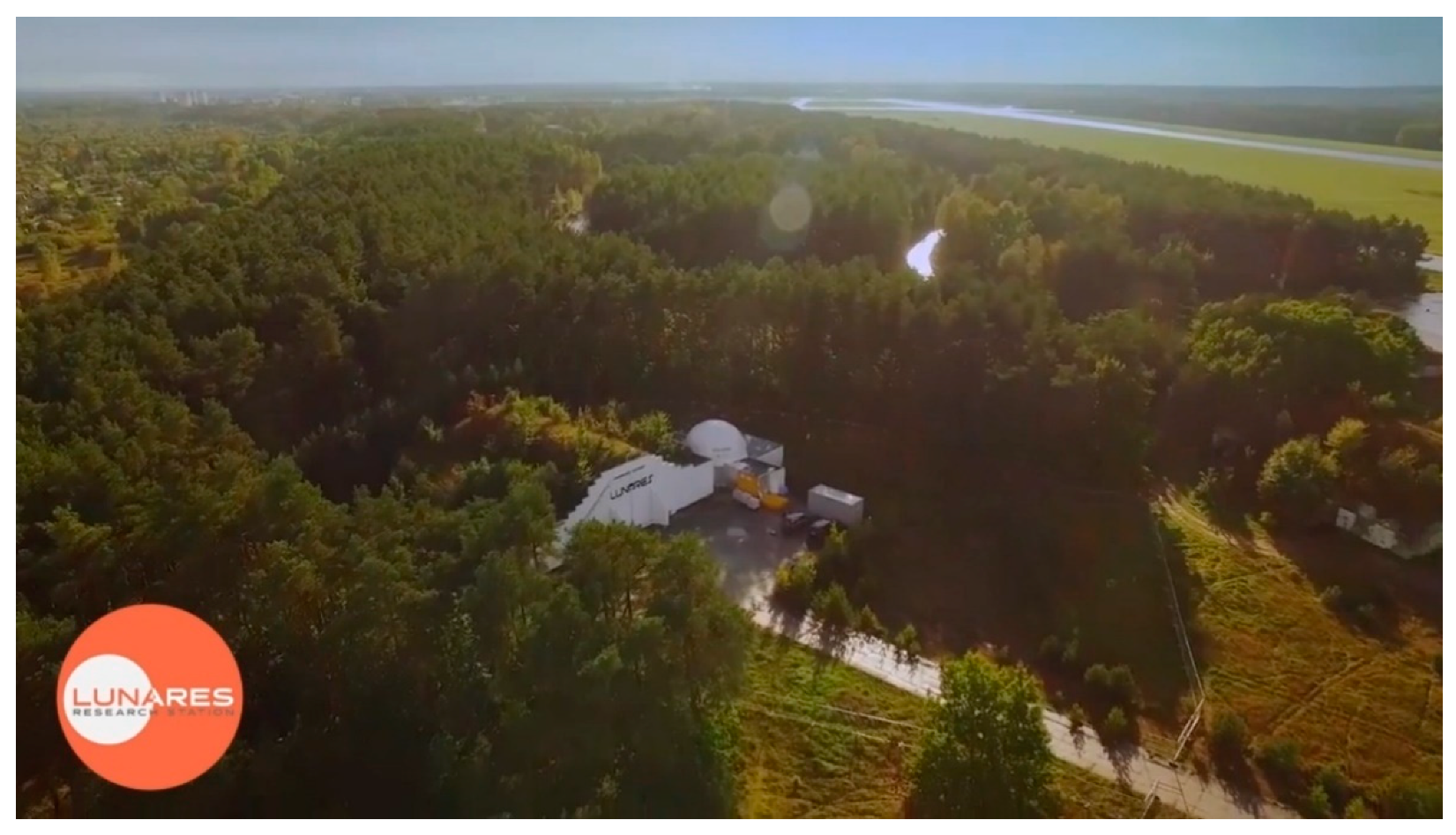
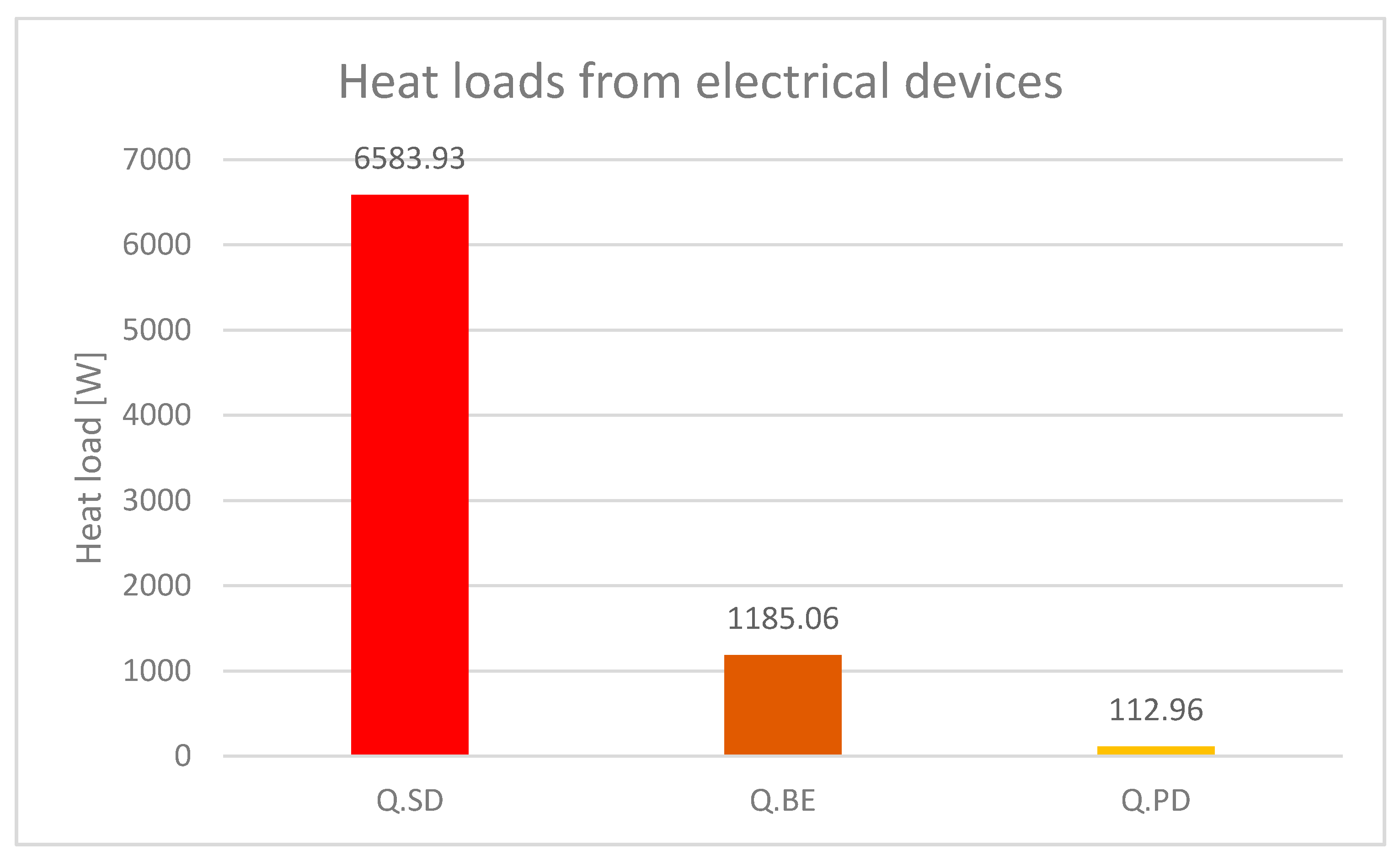

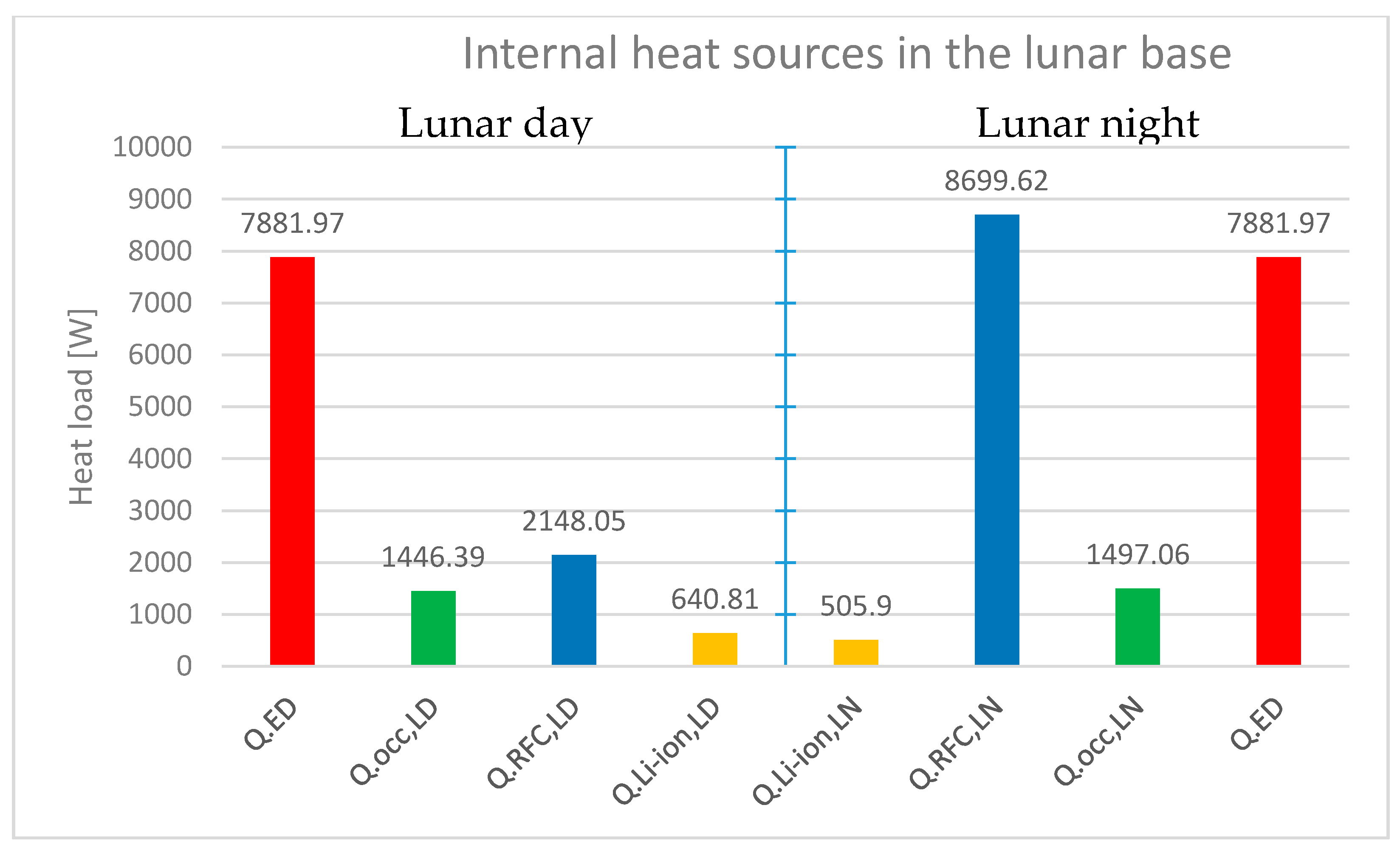
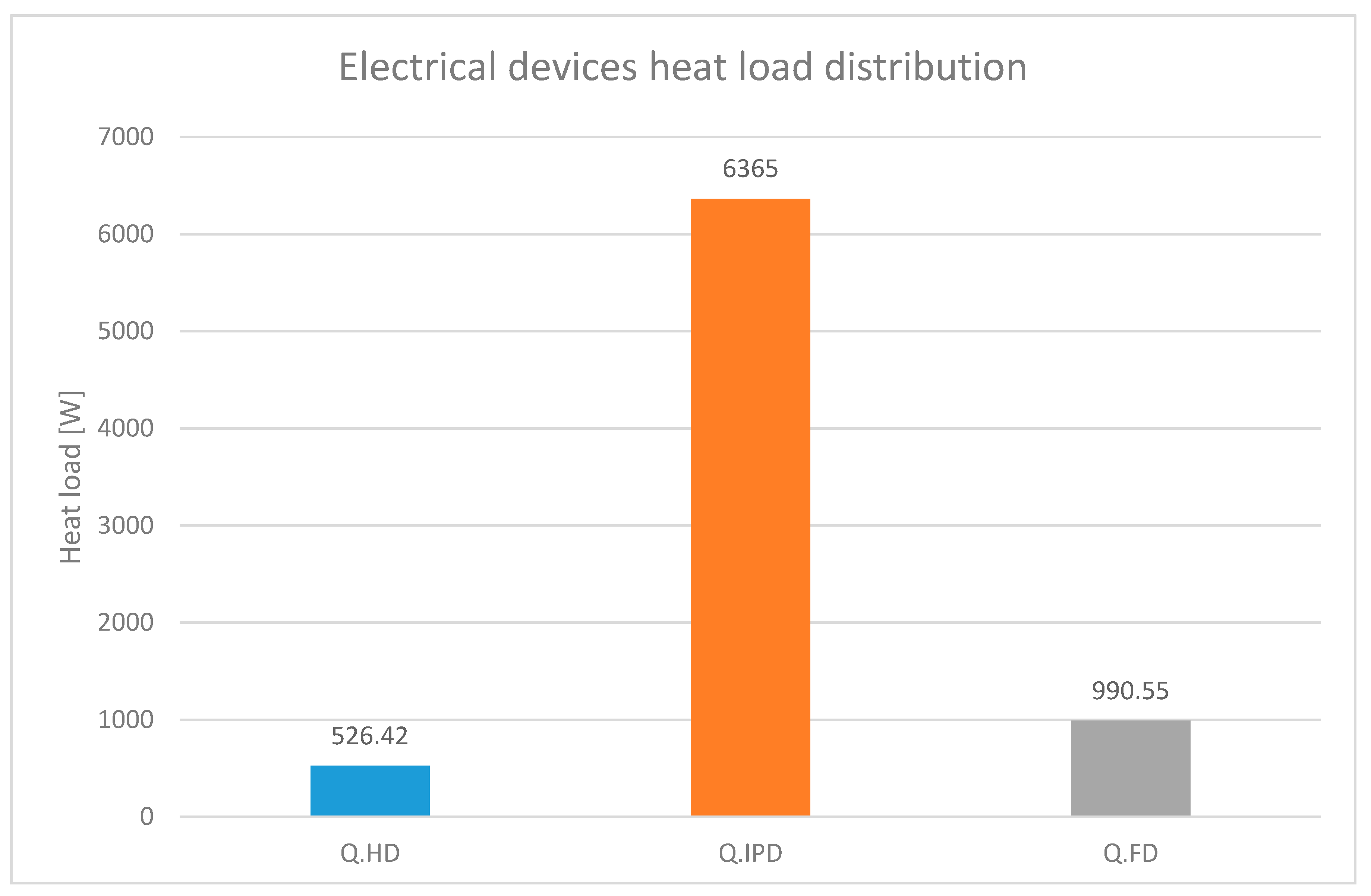

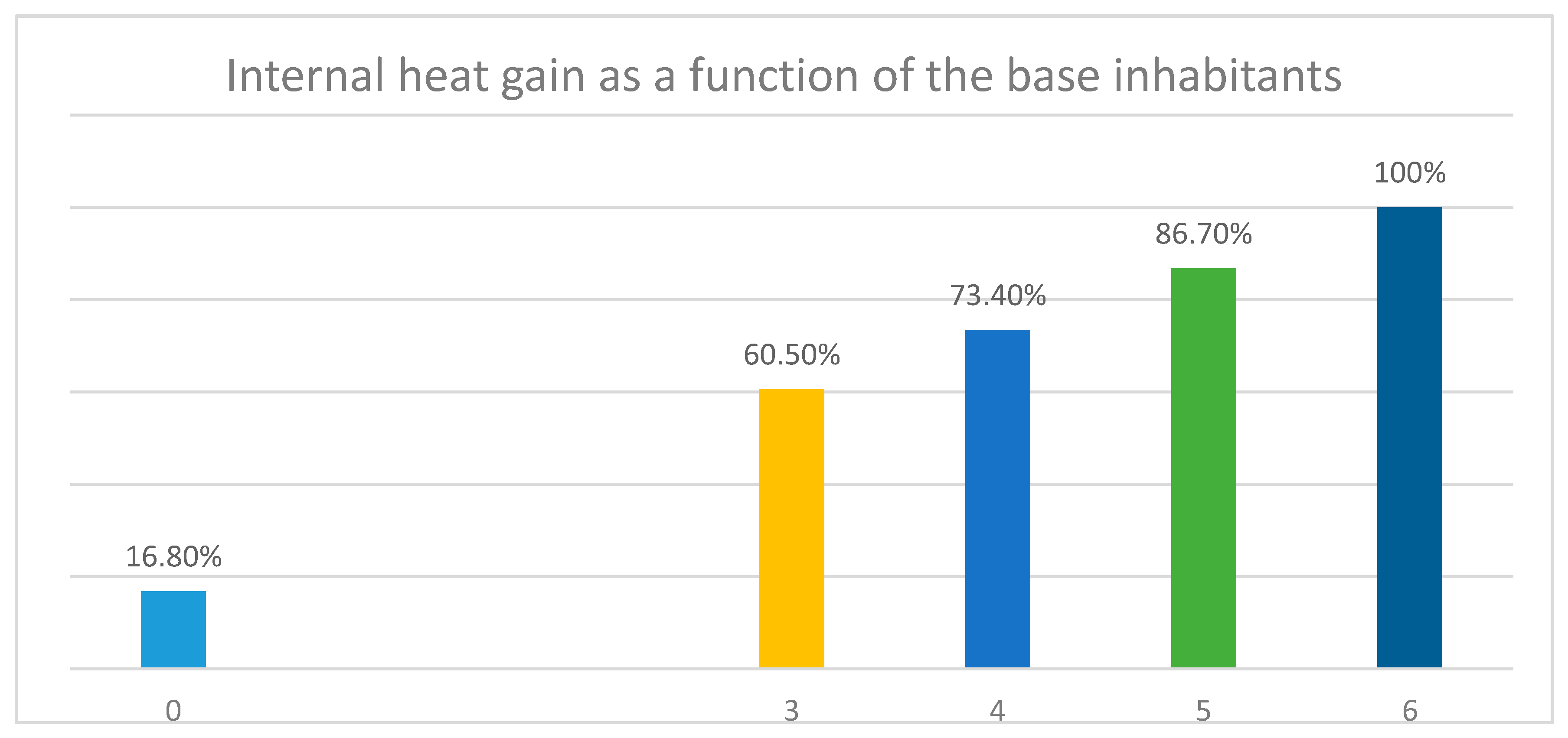
| No. | Compartment | Floor Surface Area [m2] | Interior Volume [m3] |
|---|---|---|---|
| 1 | Workshop | 17.2 | 28.8 |
| 2 | Storage | 13.0 | 34.4 |
| 3 | Galley | 13.0 | 30.4 |
| 4 | Dormitory | 19.7 | 49.2 |
| 5 | Operations room | 19.7 | 49.2 |
| 6 | Biolab | 8.0 | 18.3 |
| 7 | Bathroom | 8.0 | 18.3 |
| 8 | Atrium | 37.2 | 150.0 |
| 9 | Airlock | 15.5 | 34.0 |
| total: | 151.3 | 412.6 | |
| regulated temperature: | 135.8 | 378.6 |
| Crew Member | Body Surface Area [m2] |
|---|---|
| A | 1.65 |
| B | 1.63 |
| C | 1.89 |
| D | 1.86 |
| E | 1.88 |
| F | 2.25 |
| Activity Symbol | Activity Description | Terrestrial MET Range | Average Terrestrial MET | Average Lunar MET |
|---|---|---|---|---|
| PA-1 | sleep and relaxation | 0.8–1.0 | 0.9 | 0.9 |
| PA-2 | Light, mostly sedentary activities | 1.6–2.2 | 1.9 | 1.66 |
| PA-3 | exercises and moderate intensity activities | 4.0–6.0 | 5 | 2.5 |
| Property | RFCs | Li-ion |
|---|---|---|
| ηRT round trip energy efficiency | 50% | 90% |
| ηreg energy efficiency of the regenerative cycle | 90% | 94% |
| ηDIS energy efficiency of the discharge cycle | 55% | 95% |
| e specific energy [Wh/kg] | 780 | 250 |
| Compartment | Device | Quantity | Mean Power Demand [W] | Mean Daily Use [h] | Daily Mean Heat Generation [W] |
|---|---|---|---|---|---|
| 1 | 3D printer | 1 | 700 | 12 | 350 |
| 6 | air compressor | 1 | 3.5 | 24 | 3.5 |
| 8 | airlock status LEDs | 2 | 5 | 24 | 10 |
| 8 | artificial daylight LEDs | 1 | 150 | 24 | 150 |
| 3 | domestic water electric heater | 1 | 2200 | 0.033 | 3.025 |
| 7 | domestic water electric heater | 1 | 4000 | 0.62 | 103.33 |
| 3 | induction oven | 1 | 2000 | 0.25 | 20.83 |
| all but 7 | interior monitoring camera 9× | 9 | 5 | 24 | 45 |
| 1 | Laptop | 1 | 60 | 12 | 30 |
| 5 | laser printer | 1 | 800 | 0.03 | 1.11 |
| 8 | 65” LCD display | 1 | 160 | 24 | 160 |
| all but 8 | lighting LED lamps | 33 | 20 | 4 | 110 |
| 1 | magnetometer battery charger | 1 | 4 | 0.14 | 0.0024 |
| 6 | microcentrifuge (4×) | 4 | 3 | 24 | 12 |
| 3 | microwave | 1 | 800 | 0.75 | 25 |
| 6 | plant lighting type A | 1 | 10 | 24 | 10 |
| 6 | plant lighting type B | 2 | 16 | 24 | 32 |
| 6 | plant lighting type C | 3 | 32 | 24 | 96 |
| 3 | Projector | 1 | 60 | 0.5 | 1.25 |
| 5 | SocSenSys devices | 1 | 20 | 24.00 | 20 |
| 1 | soldering iron | 1 | 100 | 0.083 | 0.34 |
| 1 | spectrometer | 1 | 20 | 2 | 1.67 |
| in total QBE = 1185.06 | |||||
| Name | Nominal Power Input [W] | Mean Daily Use [h/day] | Daily Mean Heat Generation [W] |
|---|---|---|---|
| Laptop 1 | 65 | 9 | 24.38 |
| Camera | 10 | 2 | 0.83 |
| e-book reader | 5 | 0.25 | 0.05 |
| Laptop 2 | 80 | 6 | 20.00 |
| Camera | 10 | 0.5 | 0.21 |
| Smartphone | 2 | 0.2 | 0.02 |
| IR camera | 10 | 0.25 | 0.10 |
| Laptop 3 | 60 | 2 | 5.00 |
| Smartphone | 2 | 1 | 0.08 |
| Laptop 4 | 80 | 10 | 33.33 |
| mp3 player | 5 | 2 | 0.42 |
| Laptop 5 | 65 | 8 | 21.67 |
| Laptop 6 | 70 | 2 | 5.83 |
| Smartphone | 5 | 5 | 1.04 |
| in total QPD = 112.96 | |||
| Device | Nominal Power Input [W] | Daily Use [h/day] | Daily Mean Heat Generation [W] |
|---|---|---|---|
| Environmental control and life support systems | 4500 | 24 | 4500.00 |
| Airlock vacuum pump | 500 | 0.083 | 1.74 |
| Spacesuit battery charger | 140 | 6 | 10.50 |
| Sample drill battery charger | 2000 | 1 | 25.00 |
| Communication system internal components | 1500 | 24 | 1500.00 |
| Communication system external components | 1000 | 24 | 0.00 |
| Central computer | 100 | 24 | 100.00 |
| Treadmill | 800 | 4.5 | 150.00 |
| Electrical power systems | 200 | 24 | 200.00 |
| Refrigerator | 10 | 24 | 10.00 |
| Welder | 5000 | 0.083 | 17.36 |
| Laboratory electric arc furnace | 5000 | 0.05 | 10.42 |
| Hair dryer | 1200 | 0.067 | 3.33 |
| Washing machine | 2000 | 0.5 | 41.67 |
| Vacuum cleaner | 1.5 | 0.5 | 0.03 |
| Subtractive manufacturing device | 2000 | 0.17 | 13.89 |
| In total: QSD = 6583.93 | |||
| Crew Member | Daily Time Spent on Activities [h] | Daily Mean Sensible Heat Generation [W] | ||
|---|---|---|---|---|
| PA-1 | PA-2 | PA-3 | ||
| A | 9 | 12.5 | 1.75 | 132.62 |
| B | 9 | 13 | 1.25 | 129.49 |
| C | 9 | 12.75 | 1.5 | 151.10 |
| D | 9 | 13 | 1.25 | 147.63 |
| E | 9 | 13 | 1.25 | 149.51 |
| F | 9 | 11.5 | 2.75 | 185.69 |
| in total: QSBH,LD = 896.04 | ||||
| Crew Member | Daily Time Spent on Activities [h] | Daily Mean Sensible Heat Generation [W] | ||
|---|---|---|---|---|
| PA-1 | PA-2 | PA-3 | ||
| A | 9 | 12.5 | 2.5 | 140.10 |
| B | 9 | 13 | 2 | 136.89 |
| C | 9 | 12.75 | 2.25 | 159.68 |
| D | 9 | 13 | 2 | 156.07 |
| E | 9 | 13 | 2 | 158.06 |
| F | 9 | 11.5 | 3.5 | 195.91 |
| in total: QSBH,LN = 946.71 | ||||
| Energy Storage | Cooling Load [W] | |
|---|---|---|
| Lunar Day | Lunar Night | |
| RFC | 16,683.01 | 14,055.37 |
| Li-ion | 15,175.76 | 5861.66 |
| Energy Storage | Electric Power Consumption [W] | |
|---|---|---|
| Lunar Day | Lunar Night | |
| RFC | 2078.23 | 1750.90 |
| Li-ion | 1890.47 | 730.20 |
| Energy Storage | Heat Load [W] | |
|---|---|---|
| Lunar Day | Lunar Night | |
| RFC | 2148.05 | 8699.62 |
| Li-ion | 640.81 | 505.90 |
| RFC | Li-ion | |||
|---|---|---|---|---|
| Lunar Day | Lunar Night | Lunar Day | Lunar Night | |
| Internal heat gains [W] | 11,476.41 | 18,078.65 | 9969.17 | 9884.93 |
| Internal heat gains per unit of floor surface [W/m2] | 84.51 | 133.13 | 73.41 | 72.79 |
| Heat Source | Heat Load [W] | Heat Load per Unit of Floor Surface [W/m2] |
|---|---|---|
| Electric devices | 7881.97 | 58.04 |
| Occupation LD | 1446.39 | 10.65 |
| Occupation LN | 1497.06 | 11.02 |
| RFC LD | 2148.05 | 15.82 |
| RFC LN | 8699.62 | 64.06 |
| Li-ion LD | 640.81 | 4.72 |
| Li-ion LN | 505.90 | 3.73 |
| Symbol | Description | Value |
|---|---|---|
| CN | number of crew members | 6 |
| BSAmean | mean body surface area of the crew | 1.86 m2 |
| PA-1 | time spent on sleep and relaxation | 9.00 h/day |
| PA-2 | time spent on light, mostly sedentary activities | 12.63 h/day |
| PA-3 | time spent on exercises and moderate intensity activities | 2.00 h/day |
| Device | Mean Power Demand [W] |
|---|---|
| air compressor | 3.5 |
| airlock status LEDs | 5 |
| artificial daylight LEDs | 150 |
| 65” LCD display | 160 |
| Microcentrifuge (4x) | 3 |
| plant lighting type A | 10 |
| plant lighting type B | 16 |
| plant lighting type C | 32 |
| projector | 60 |
| refrigerator | 10.00 |
| washing machine | 2000 |
| Device | Mean Power Demand [W] | ODF Occupancy Dependence Factor |
|---|---|---|
| Interior monitoring camera 9× | 5 | 0 |
| SocSenSys devices | 20 | 0.9 |
| Environmental Control and Life Support Systems | 4500 | 0.85 |
| Communication system internal components | 1500.00 | 0.66 |
| Communication system external components | 1000.00 | 0.7 |
| Central computer | 100.00 | 0.3 |
| Electrical Power Systems | 200 | 0.65 |
| Combination | CN Number of Inhabitants [-] | BSAmean Body Surface Area [m2] | Mean Time Spent on PA-3 [h/day] | CPD Power Demand Coefficient [-] | |
|---|---|---|---|---|---|
| No | Description | ||||
| 1 | max. crew number (nominal parameters) | 6 | 1.86 | 2 | 1 |
| 2 | min. crew number | 3 | 1.86 | 2 | 1 |
| 3 | max. BSA.mean | 6 | 1.95 | 2 | 1 |
| 4 | min. BSA.mean | 6 | 1.75 | 2 | 1 |
| 5 | increased exercising | 6 | 1.86 | 3 | 1 |
| 6 | reduced exercising | 6 | 1.86 | 1 | 1 |
| 7 | increased power demand | 6 | 1.86 | 2 | 3 |
| 8 | reduced power demand | 6 | 1.86 | 2 | 0.5 |
| 9 | uninhabited base | 0 | - | - | - |
| 10 | min. Parameters | 3 | 1.75 | 1 | 0.5 |
| 11 | max. Parameters | 6 | 1.95 | 3 | 3 |
| Combination | Heat Loads [W] | |||||
|---|---|---|---|---|---|---|
| Occupational Qocc,mean | Electrical Devices | Energy Storage System | ||||
| RFC | Li-ion | |||||
| Lunar Day | Lunar Night | Lunar Day | Lunar Night | |||
| 1 | 1471 | 7882 | 2147 | 8697 | 641 | 506 |
| 2 | 735 | 4890 | 1291 | 5229 | 385 | 304 |
| 3 | 1517 | 7882 | 2149 | 8702 | 641 | 506 |
| 4 | 1418 | 7882 | 2146 | 8691 | 640 | 505 |
| 5 | 1494 | 7882 | 2148 | 8699 | 641 | 506 |
| 6 | 1448 | 7882 | 2147 | 8694 | 640 | 506 |
| 7 | 1471 | 9863 | 2648 | 10726 | 790 | 624 |
| 8 | 1471 | 7387 | 2022 | 8189 | 603 | 476 |
| 9 | 0 | 1372 | 480 | 1945 | 274 | 216 |
| 10 | 698 | 4643 | 1227 | 4971 | 366 | 289 |
| 11 | 1541 | 9863 | 2650 | 10734 | 791 | 624 |
| Combination | QINT Total Internal Heat Gain [W] | |||
|---|---|---|---|---|
| RFC | Li-ion | |||
| Lunar Day | Lunar Night | Lunar Day | Lunar Night | |
| 1 | 11,500 | 18,049 | 9993 | 9858 |
| 2 | 6917 | 10,855 | 6011 | 5930 |
| 3 | 11,547 | 18,100 | 10,040 | 9905 |
| 4 | 11,445 | 17,990 | 9940 | 9805 |
| 5 | 11,524 | 18,075 | 10,016 | 9882 |
| 6 | 11,477 | 18,024 | 9971 | 9836 |
| 7 | 13,982 | 22,060 | 12,124 | 11,958 |
| 8 | 10,879 | 17,047 | 9461 | 9334 |
| 9 | 1852 | 3317 | 1646 | 1588 |
| 10 | 6568 | 10,312 | 5707 | 5630 |
| 11 | 14,054 | 22,138 | 12,194 | 12,028 |
| Combination | qINT Total Internal Heat Gain per Unit Floor Surface [W/m2] | |||
|---|---|---|---|---|
| RFC | Li-ion | |||
| Lunar Day | Lunar Night | Lunar Day | Lunar Night | |
| 1 | 84.68 | 132.91 | 73.59 | 72.60 |
| 2 | 50.93 | 79.93 | 44.26 | 43.66 |
| 3 | 85.03 | 133.29 | 73.93 | 72.94 |
| 4 | 84.28 | 132.48 | 73.19 | 72.20 |
| 5 | 84.86 | 133.10 | 73.76 | 72.77 |
| 6 | 84.51 | 132.73 | 73.42 | 72.43 |
| 7 | 102.96 | 162.45 | 89.28 | 88.05 |
| 8 | 80.11 | 125.53 | 69.67 | 68.73 |
| 9 | 13.64 | 24.43 | 12.12 | 11.69 |
| 10 | 48.37 | 75.93 | 42.02 | 41.46 |
| 11 | 103.49 | 163.02 | 89.80 | 88.57 |
© 2020 by the authors. Licensee MDPI, Basel, Switzerland. This article is an open access article distributed under the terms and conditions of the Creative Commons Attribution (CC BY) license (http://creativecommons.org/licenses/by/4.0/).
Share and Cite
Kaczmarzyk, M.; Starakiewicz, A.; Waśniowski, A. Internal Heat Gains in a Lunar Base—A Contemporary Case Study. Energies 2020, 13, 3213. https://doi.org/10.3390/en13123213
Kaczmarzyk M, Starakiewicz A, Waśniowski A. Internal Heat Gains in a Lunar Base—A Contemporary Case Study. Energies. 2020; 13(12):3213. https://doi.org/10.3390/en13123213
Chicago/Turabian StyleKaczmarzyk, Marcin, Aleksander Starakiewicz, and Aleksander Waśniowski. 2020. "Internal Heat Gains in a Lunar Base—A Contemporary Case Study" Energies 13, no. 12: 3213. https://doi.org/10.3390/en13123213
APA StyleKaczmarzyk, M., Starakiewicz, A., & Waśniowski, A. (2020). Internal Heat Gains in a Lunar Base—A Contemporary Case Study. Energies, 13(12), 3213. https://doi.org/10.3390/en13123213





